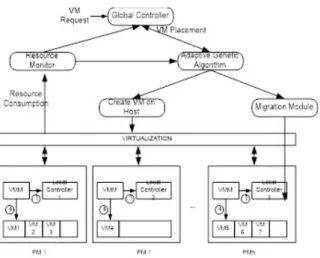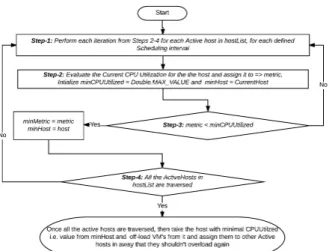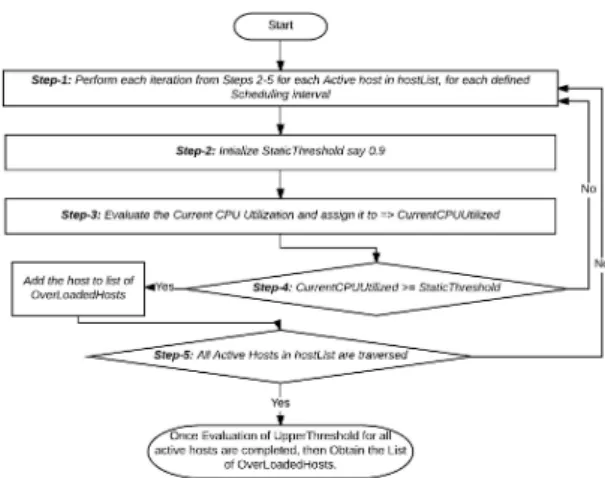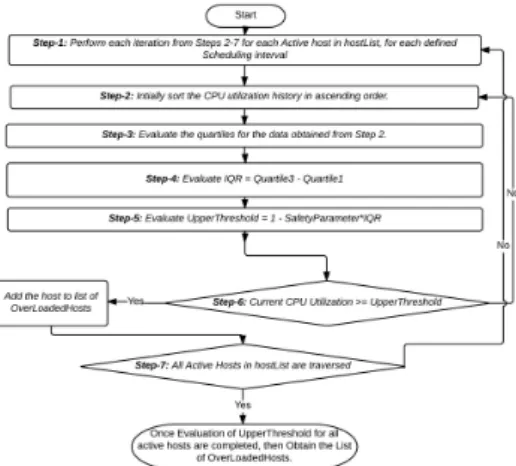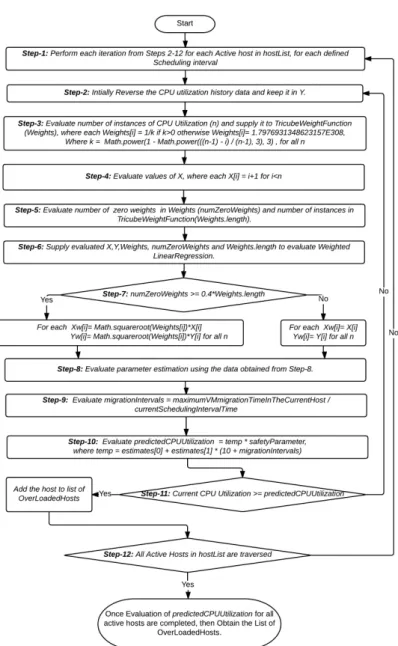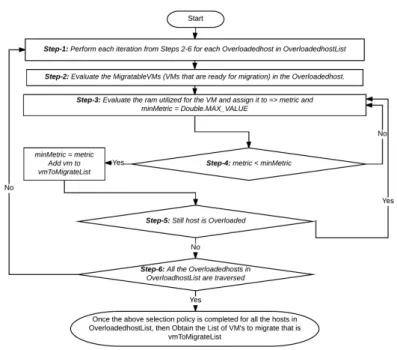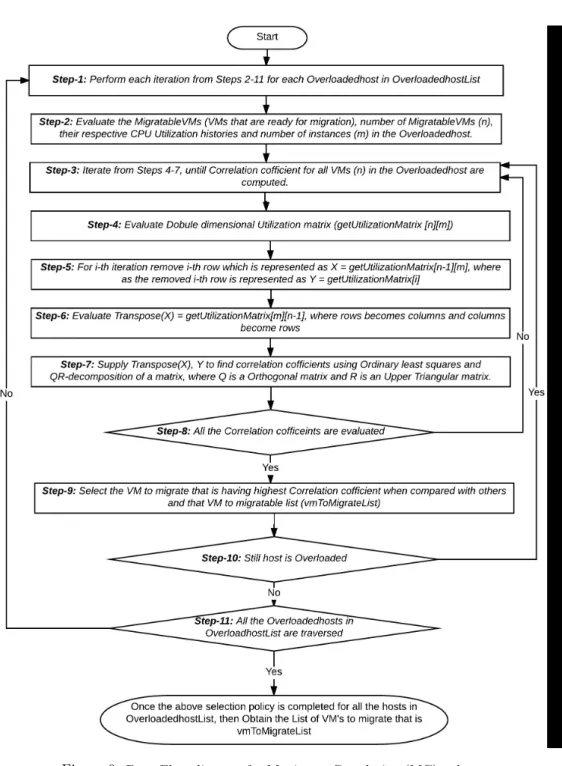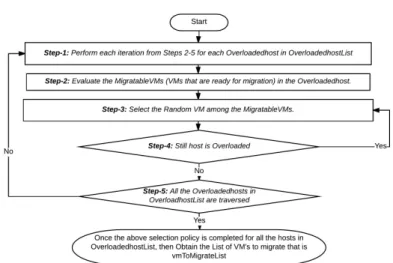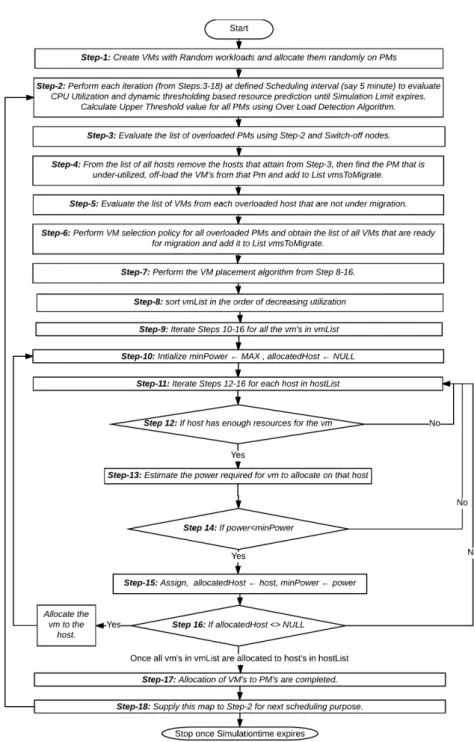Evolutionary computing based QoS oriented energy efficient VM consolidation
scheme for large scale cloud data centers using random work load bench
Perla Ravi Theja
∗, SK. Khadar Babu
aVIT University, Vellore Campus Vellore - 632 014, Tamilnadu, India
ravithejaperla9048@gmail.com khadar.babu36@gmail.com
Submitted December 22, 2015 — Accepted June 7, 2016
Abstract
In order to assess the performance of an approach, it is unavoidable to inspect the performance with distinct datasets with diverse characteristics. In this paper we had assessed the system performance with random workbench datasets. A-GA (Adaptive Genetic Algorithm) based consolidation technique has been compared with other consolidation techniques including dynamic CPU utilization techniques, VM (Virtual Machine) selection and placement policies. The proposed consolidation system had exhibited better results in terms of energy conservation, minimal Service Level Agreement (SLA) violation and Quality of Service (QoS) assurance.
MSC:68U20; 68U99; 65K10; 65K05
1. Introduction
As computing requirements is changing in a huge rate in all-most all the bossi- ness’s, there requires optimal utilization of resources which yields in saving costs, which motivated everyone to make use of Cloud computing. The key issues with
∗Corresponding author http://ami.ektf.hu
217
Cloud computing are energy consumption, SLA violation, Cloud Network Security and Privacy. As per report from Natural Resources Defence Council (NRDC), in 2013 data centers in USA used around 91 billion kilowatt-hours of electricity that is matching to the annual output of 34 large (500-megawatt) coal-fired power plants.
By 2020 this demand may increase to roughly 140 billion kilowatt-hours that is matching to annual output of 50 power plants, costing American businesses 13 bil- lion USD annually in electricity bills and emitting nearly 100 million metric tons of carbon pollution per year [21]. In this paper we are concentrating on energy con- servation, reducing SLA violation and providing QoS assurance by implementing dynamic thresholding based resource utilization detection approach for real time cloud systems and by developing an evolutionary computing paradigm based A-GA for VM Placement Policy in VM Consolidation application. In this paper we ex- hibited performance analysis of the proposed system with other approaches having diverse CPU utilization approaches i.e. (Static Threshold (THR), Local Regres- sion (LR), Robust Local Regression (LRR), Median Absolute Deviation (MAD), and Inter Quartile Range (IQR) etc.), VM selection policies i.e. (Minimum Migra- tion Time (MMT) Maximum Correlation (MC) and Random Selection (RS)) and VM placement policies i.e. ( Power Aware Best Fit Decreasing (PABFD) and Ant Colony Optimization (ACO)).
2. Related work
Lot of researches have made research on VM consolidation approaches [11, 16, 17, 23] for QoS and energy optimization. Coming to overload detection in data cen- ters, researchers primarily made use of the static threshold approach [3], where they used overall CPU utilization and defined static thresholds. As dynamic prediction is better than Static prediction researches directed towards dynamic cloud pattern and workloads [4]. On the basis of the historical pattern of CPU utilization, Buyya et al [4] came up with a dynamic threshold scheme for upper and lower bound esti- mation. Regression based CPU utilization was suggested in [9, 10], where the CPU utilization was estimated at host nodes. Various researches used linear regression and the K-nearest neighbour regression schemes for approximating the data re- trieved throughout the VMs lifetime. They gave importance for SLA optimization.
Later, bin packing problem was considered in [1, 24, 25] for efficient VM consolida- tion. All most all existing approaches have used PABFD based consolidation [23].
Lot of algorithms tried to maximize number of host’s shutdown by providing server consolidation. Multiple researches tried to provide dynamic schemes for optimal consolidation [6, 7, 13].
Various researches tends towards green cloud computing using bio-inspired tech- nique [2]. Resource provision through ant colony model was inspected in [14]. For the purpose of VM placement, ACO and GA were suggested in [5] and [8] respec- tively. Disintegrated ACO placement scheme was put forwarded in [12]. Resource placement module in virtualization using GA was inspected in [15, 22, 26]. Great number of current researchers had concentrated either on VM selection or VM
218 P. R. Theja, SK. K. Babu
Figure 1: Proposed system architecture
placement. Real work load based A-GA VM placement schemes are used in vari- ous researches [18, 19, 20].
3. Our contribution
In our earlier work we validated the optimal efficiency of our proposed A-GA based consolidation with MMT selection policy and combined IQR and LRR CPU predic- tion schemes by simulation using real world work load from more than a thousand planet-lab virtual machines [18, 19, 20]. In this paper, we performed comparative analysis between different combinations of host overload detection algorithms, VM selection policies and VM placement policies for random workload traces.
3.1. Cloud model
As a part of large scale cloud infrastructure we considered varied physical machines (PMs) or hosts, which are attributed in terms of its CPU consumption and Millions Instructions per Second (MIPS). Storage will be allotted using Storage area network which supports VM migration. Here VMs seek MIPS which will be allotted to carry work.
The VM consolidation minimizing number of active hosts by allotting VM’s to run on each single PM so as to conserve energy and to facilitate optimal resource consumption. This process involves SLA Violation and downtime which need to be minimized by applying optimal algorithms. Proposed VM Consolidation scheme as shown in Figure 1 involves two controllers i.e. Global and Local Controllers.
Local Controller (LC) which periodically check the status of PM whether it is Overloaded/Underloaded. If it is Overloaded it will report to Virtual Machine
Figure 2: Data Flow diagram for Host under load detection algo- rithm
Manager (VMM), which in turn triggers VM selection policy and decides which VMs that need to be offloaded to avoid SLA performance degradation and reports to Global Controller (GC) which places these VMs onto other active hosts in a way that they shouldn’t overload again using VM placement polices. If it is underloaded then in same way VMM triggers VM selection policy and GC uses VM placement policy to place these VM’s.
3.1.1. Host under load and overload detection
The following data flow diagram i.e. Figure 2, illustrates, how the Host under detection algorithm is carried-out. The outcome of this algorithm is minimum CPU utilized host, which will be slept (turned-off) resulting in energy conserva- tion. To investigate whether the host is overloaded or not, we make use of host overload detection algorithms. Here we considered various algorithms i.e. (Median Absolute Deviation (MAD), Static Threshold (THR), Inter Quartile Range (IQR), Local Regression (LR) and Local Robust Regression (LRR)) for this purpose. The process-flow of each algorithm is illustrated completely in terms of data flow dia- grams in Figures 3 to 7 respectively as mentioned below:
To detect the overloaded host node, each host node initializes an overload de- tection scheme intermittently to perform VM de-consolidation, thus enabling SLA violation avoidance. CPU utilization of the host node has been used for identifying overloaded hosts. Unlike conventional schemes based on static threshold, in this paper we have developed a dynamic threshold based adaptive CPU utilization and overload detection scheme. It enables the proposed system to behave in real time scenario where there is highly fluctuating resource utilization. It adjusts resource
220 P. R. Theja, SK. K. Babu
Figure 3: Data Flow diagram for Median Absolute Deviation (MAD) algorithm
Figure 4: Data Flow diagram for Static Threshold (THR) algo- rithm
Figure 5: Data Flow diagram for Inter Quartile Range (IQR) al- gorithm
utilization threshold based on the variation in CPU utilization and utility map. It can be observed that higher deviation might even result into100%CPU utilization that signifies higher overloading probability. To enable dynamic threshold detec- tion scheme, we have used Interquartile Range (IQR) and robust local regression (LRR) algorithm. In our proposed model, the resource utilization has been exam- ined at the interval of 5 minute and for each odd iteration, IQR algorithm has been used, while LRR has been scheduled for even iterations. Such novelty intends to employ major advantages of both approaches. A brief of IQR is given as follows:
IQR is a statistical dispersion technique which is equivalent to the differences be- tween the third and first quartile. To estimate dynamic CPU utilization threshold, the following equation has been used.
IQR=Q3−Q1, Tm= 1−s.IQR (3.1) Where s represents the safety parameter that states the maximum extent of the tolerability of a host node in Cloud environment and its lower value signifies the higher tolerance to the fluctuation in the CPU utilization. Here we have used s= 1.2,and it can be changed to examine the optimal performance. In addition to IQR, we have used Loess concept [18] to derive the LRR algorithm, which has been employed for fitting a trend polynomial to the earlierk observations for the CPU utilization called utilization map. For initial recent observations, it is retrieved as
ˆ
g(x) = (ˆa) + ˆbx (3.2)
It is further used for calculating the next observationg(xˆ k+1).To offload some VMs from an overloaded host node, the following conditions have been fulfilled:
s.ˆg(xk+1)≥1, xk+1−xk ≤tm (3.3)
222 P. R. Theja, SK. K. Babu
Figure 6: Data Flow diagram for Local Regression (LR) algorithm
Figure 7: Data Flow diagram for Local Robust Regression (LRR) algorithm
224 P. R. Theja, SK. K. Babu
Where s ∈ R+ is the safety parameter that signifies the maximum capability or tolerability of a host node andtm represents the maximum time required for mi- grating a VM from the overloaded host. The traditional Loess concept [18] is found vulnerable to the outliers caused due to leptokurtic or heavy-tailed distributions.
To alleviate this problem, we have modified the Loess concept [18] to bisquare from the conventional least-squares (LR) approach. Thus we have LRR approach iteratively for estimating the initial fitting and tricube weight function has been used for dynamic weight estimation. The fitting parameter has been retrieved at xito get optimal value by means ofyˆi.Thus, the final residual value isi=yi−yˆi. Furthermore, the final retrieved value(xi, yi)has been assigned a robustness factor Ri that primarily depends on the magnitude ofi.Mathematically,Ri is obtained as
Ri=B ˆi
6LM AD
(3.4) Where B(.)gives the bisquare weight function and LM AD represents the Median Absolute Deviation (MAD) for the least square fit. Mathematically:
B(.) =
((1−u2)2 if|u|<1,
0 otherwise.
In this paper, we assigned Ri for each observation (5 minute), where LM AD has been obtained as:
LM AD=median|ˆi| (3.5) Using equation (3.3), the next observation has been obtained for the estimated trend line, where observing any inequalities, the host can be identified as over- loaded.
3.1.2. VM selection policy
In this phase, the VM selection takes place where it is intended to select the VM which should be migrated to minimize overhead from overloaded host. Estimating the dynamic CPU utilization threshold, VM selection has been performed that offloads host for avoiding SLA violation and unwanted energy consumption caused due to overload. In this paper, we have examined three different selection policies;
the Minimum Migration Time (MMT), Maximum Correlation (MC) and Random Selection (RS) policy. A brief discussion of the implemented VM selection policies with respective data flow diagrams are reprsented in Figures 8 to 10 as mentioned below:
1. Minimum Migration Time(MMT) Policy
Once assessing the host’s CPU utilization levels and identifying any probable or overloaded host, VMs selection algorithm performs offloading of that host node to avoid any probability of SLA violation. The developed MMT selec- tion policy performs migration of only those VMs(v)which requires minimal migration time than the other. In this paper, the migration time has been
Figure 8: Data Flow diagram for Minimum Migration Time (MMT) policy
estimated in terms of the resource, RAM being used by VM divided by the supplementary network bandwidth available for hostj. Let V(j) be a set of VMs connected with the hostj. Therefore, the VM to be migrated is selected based on the following condition.
v∈Vj|∀a ∈Vj,RAMu(v)
N ETj ≤RAMu(a)
N ETj (3.6)
WhereRAMu(a)depicts the amount of RAM currently being used by VMa;
andN ETj refers the bandwidth available for migration from the hostj.
2. Maximum Correlation (MC) Policy
In case of maximum correlation [19][20] policy, it is assumed that the higher correlation between the CPU utilization by VMs connected to certain host signifies higher overloading probability. In MC policy, VMs having highest correlation for the CPU utilization are needed to be migrated from the cur- rent host to assist energy conservation and SLA violation avoidance. We have used the concept of multiple correlation coefficients (MCC) for estimating the intra-VM correlation and respective CPU utilization. The used MCC coef- ficients are in relation to the squared correlation between the real and the predicted values of the dependent variable. In fact, it can be interpreted as the fraction of variance of the dependent variable elucidated by the associated
226 P. R. Theja, SK. K. Babu
independent variables.
Let X1, X2,· · · , Xn be the CPU utilization of n VMs connected to a host and Y be the specific VM to be migrated, where(n−1)are the random in- dependent variables. Here Y being the VM to be migrated, be the dependent variable. In our proposed MC policy, we have calculated the correlation be- tweenY and(n−1).The obtained augmented matrix(n−1)×nencompasses the observed instances or the values of(n−1),indicated asX.Similarly, the observation vector or mapped vector (n−1)×1 of the dependent variable Y be y.Thus, the overall observation vector or the mapping vectors for the VM’s CPU utilization can be given as follows:
x=
1 x1,1 · · · x1,n−1 ... ... ... ...
1 xn−1,1 · · · xn−1,n−1
, y=
y1
...
yn−1
(3.7)
Observing equation (3.7), it can be found that the first column ofX is all 1 (for all instances), therefore it can be considered as an augmented matrix.
The predicted values of the VM’s CPU utilization or Y can be presented as Y ,ˆ which can be obtained byYˆ =Xb, whereb= (XTX)−1XTY.Obtaining the predicted values, MCC coefficients, the final correlationR2Y,1,···,n−1 has been obtained as
R2Y,X1,···,Xn−1 = Pn
i=1(Yi−mY)2( ˆYi−mYˆ)2 Pn
i=1(Yi−mY)2Pn
i=1( ˆYi−mYˆ)20 (3.8) WheremY and mY give the observation means ofY andYˆ respectively. In MC based VM selection, the MCCs for all mapped instancesXi have been obtained as R2Xi,X1,···,Xi−1,Xi+1,. . . ,Xn. Finally, based on correlation value, Eq. (3.9) has been used to select a specific VM to be migrated:
v∈V Mj|∀a
∈Vj, R2Xvm,X1,···,Xvm−1,Xv+1Xn (3.9)
≥R2Xv,X1,···,Xa−1,Xa+1,···,Xn. (3.10) In addition to the MMT and MC selection policy, we have also examined an algorithm called random selection (RS) policy.
3. Random Selection Policy
In Random Selection policy, a VM is randomly selected for migration from the host node as per a uniformly distributed discrete random variableA = U(0|Vj),whose values signify a set of VMs,Vj placed atjth host. Since VM consolidation is a bin packing problem and therefore, an optimal approach for placement is of great significance to ensure minimal downtime, energy consumption and probable SLA violation. The following section discusses the proposed evolutionary computing based VM placement approach.
Figure 9: Data Flow diagram for Maximum Correlation (MC) pol- icy
228 P. R. Theja, SK. K. Babu
Figure 10: Data Flow diagram for Random Selection (RS) policy
3.1.3. VM placement policy
VM placement can be stated to be a problem of bin packing that encompasses bins, items and prices as the three parameters, where bins represent the host nodes, VMs represent the items to be allocated, bin size refers the available resource on the host node; and the resource or CPU power consumed by a host is stated in terms of price. In bin packing, it is intended to accommodate as much as VMs that makes the overall scenario NP-hard. In order to deal with such non-convexity problem, certain heuristic approach or evolutionary computing scheme can be the potential solution. In this paper, we have proposed Adaptive Genetic Algorithm (A- GA) as VM placement policy. We have interfaced A-GA with CloudSim simulator comprising multiple host nodes, and VMs in the data center. In our proposed model, each host is equipped with one or multiple processing elements (PE). The executing VMs on the hosts have one or multiple running Cloudlets. In simulation model, the user requests have been stated in terms of Cloudlets, where the needed processing power for each Cloudlet has been defined in terms of Million Instructions Per Second (MIPS). In the proposed placement policy, the scheduler considers all hosts, VMs and VM maps as input and generates mapping for nodes, where it divides overall MIPS into different components like hosts and VMs running in parallel. The functional discussion of the proposed A-GA scheme is given in (Figure 13).
1. A-GA Based VM Placement
As depicted in (Figure 1), the proposed A-GA processes VM scheduling based on the resource utilization information provided by local controller (LC) and the upper threshold value estimated by dynamic threshold estimation scheme.
We have considered upper threshold so as to satisfy transient variations of re- source demand by different VMs on a host node. The CPU utilization pattern
or history of VMs has been considered for VMs placement onto destination host node. Considering a large scale cloud infrastructure or data center, the time efficient and effective placement scheduling is of great significance. In this research we have intended to reduce the number of VM migration and mi- gration time, so as to enable energy efficient and QoS oriented consolidation mechanism. In addition, we have scheduled the system to enable maximum host shut down so as to conserve energy. In this paper, placing or allocating VM on certain host, our algorithm estimates the energy of the data center and accordingly performs further scheduling to minimize energy consumption.
At first, the proposed A-GA algorithm initializes a definite set of population where individual host is a tree comprising global controller as its root, hosts are the next level nodes and VMs are the child nodes (Figure 1). It calculates the total energy consumption and CPU utilization for each mapping in the deployed cloud center. Here, the VM mapping history also known as utiliza- tion pattern, allocated VMs and their resource utilization mapping, future mapping for VMs based dynamic utilization, hosts and its available resource availability etc. have been used as population. The precise discussion of the proposed system is given in (Figure 13). From these chromosomes, our proposed A-GA algorithm initially selects two VM mappings with minimal energy values on which the initial genetic operators (crossoverpc and muta- tion probabilitypm) are applied. Thus, the mapping obtained for VMs onto the host nodes is added to the overall population based on the fitness values.
In our proposed A-GA based VM placement policy,pc selects the host with the best CPU utilization based on the previous VMs mapping. Herepc and pm try to reduce host nodes by means of SWITCHING OFF or turning it into SLEEP MODE. Here, it should be noted that unlike conventional genetic approach (i.e., A-GA), we have applied adaptive genetic parameter selection, where these variables are updated dynamically after every iteration, till stop- ping criteria (100 generations) is obtained.
Consider, the host nodes in data centers beP M =pm1, pm2, pm3,· · ·, pmm
andpmibeith host node, where(1≤i≤m).Similarly, VMs in the network be V Mi =vm1, vm2, vm3,· · · , vmn,i, which are connected to the ith host.
Considervm(j,i)be the ith VM on jth PM. The variablex(i,j)signifies whether ith VM is placed on host j or not. LetP(r,i)be the resource capacity r (CPU utilization) on jth host node. The resource needed by ith VM isv(r, j).Thus, overall load on j th host node would be the sum of all resource needed by all VMs running over it. Consider,T be the duration of past observations, thus the sub-intervals can be obtained by dividingTinto(q−1)sub intervals such thatT = [(t2−t1)(t3−t2)(tq−t(q−1))]. The slot(tk−t(k−1))is the time periodk. In such manner, for periodk, we have estimated the CPU utilization
230 P. R. Theja, SK. K. Babu
at a host(CP U(i, U til)(k))using following equation:
CP U(i,U til)(k) = Xn j=1
vmCP U,j
pm(CP U, j) (3.11) Where, k represents the duration for which the CPU utilization has to be retrieved. Finally, the average CPU utilization at a host node has been obtained as:
pm(i, AvgU til) =
tXk−n t−tk
pm(i, U til)(t)
(q−1) (3.12)
Where(q−1)represents the total number of sub intervals in T time. Consider pmi represents the power of jth host node duringtk.Thus, the power utiliza- tion can be obtained in terms of CPU utilization at the host node. Consider, pmiE(k)be the power or energy consumption of thejth host node in between the last time interval and the current time, then it can be obtained as
pmiE(k)=pmiw(k−1) + (pmiw(k−1) + (pmiw(k))(tk−tk−1) (3.13) The energy consumption for the jth host,E(pmj)can be estimated at certain hostpmj having CPU usage asCP Ui,U til(k)
E(pmj) =Kj.emaxj + (1−kj).emaxj .CP Ui,U til(k) (3.14) WhereKj states the part of energy consumed when the hostpmj is in idle state; emaxj states for the energy consumption of host pmj when it being used 100%. The variable CP U(i,U til)(k) represents the CPU utilization by hostpmj. We have used this approach to estimate the energy consumption at certain host so as to perform placement scheduling. Similarly, the energy consumption for all host nodes, DE(k) can be obtained for a period using following equation:
DE(k) = Xm i=1
pmiE(k) (3.15)
In this paper, the prime objective of the proposed A-GA scheme for VM placement is to retrieve the set of mapping from VM set to the host set PM while ensuring minimal energy consumptionDE(k),provided:
∀i Xm j=1
xij−1 (3.16)
∀j Xn i=1
vmCP U,iXij ≤pmCP U,j. (3.17) In this paper A-GA is compared with ACO and PABFD VM placement algorithms. The implementation of our proposed A-GA based consolidation scheme using LRR and IQR for host overload detection and MMT for VM Selection [20] is shown in Figure 13. The whole process flow for ACO and PABFD is shown in Figure 11 and Figure 12 respectively.
Figure 11: Data Flow diagram for Power-Aware Best Fit Decreas- ing (PABFD) based VM Consolidation Scheme
232 P. R. Theja, SK. K. Babu
Figure 12: Data Flow diagram for Ant Colony Optimization (ACO) based VM Consolidation Scheme
Figure 13: Data flow diagram for proposed Adaptive Genetic Al- gorithm (A-GA) based VM Consolidation Scheme
234 P. R. Theja, SK. K. Babu
Workbench Data Number of host Nodes Number of VM’s
Random Workload 300 400, 500, 600
Random Workload 600 800,1000,1200
Random Workload 800 1000,1200,1600
Table 1: Workbench data with different number of host nodes and VM’s
4. Experimental setup
In this paper, we have examined the performance of the proposed system using random cloud workload traces. To evaluate the robustness of the proposed consol- idation scheme a large scale cloud infrastructure with different network size and configurations has been considered as per Table 1. For simulation we utilized CloudSim in Eclipse IDE. Intially, servers frequency is mapped to MIPS ratings with 1860 and 2660 MIPS in HP ProLiant ML110 G4 and HP ProLiant ML110 G5, respectively. Each server has been assigned 1 GB/s network bandwidth.
5. Results and discussion
The different simulation scenarios used for evaluation are mentioned in Table 2.
With different network and process algorithm combination, the simulations have been done and respective performance has been analyzed in terms of the following performance parameters:
1. Number of VM Migrations (in Nos.)
2. Service Level Agreement Violation (SLAV)(%) 3. SLA time per Active Host (%)
4. SLA Performance Degradation (%) 5. Number of Host Shutdown (Nos) 6. Energy Consumption (KWh)
In this paper, we plotted graphs only for random workload with 800 hosts and VMs with 1000, 1200, 1600 (as similar results are observed for 300 and 600 hosts). As shown in Figure 14, the proposed A-GA based VM consolation yields minimal VM migration thus providing minimal downtime. Figure 15 illustrates SLAV, where the proposed A-GA provides minimal SLA violation with MMT VM selection policy.
Figure 16 represents SLA performance degradation and it clearly states proposed evolutionary A-GA with IQR and LRR as overload prediction schemes and MMT
CPU Utiliza- tion Thresh- old
VM Selection VM Placement
IQR MMT MC RS Power Aware Best Fit Decreasing
LR MMT MC RS Power Aware Best Fit Decreasing
MAD MMT MC RS Power Aware Best Fit Decreasing THR MMT MC RS Power Aware Best Fit Decreasing LRR MMT MC RS Power Aware Best Fit Decreasing Combined IQR
and LRR MMT MC RS Ant Colony Optimization Combined IQR
and LRR MMT MC RS Adaptive Genetic Algorithm Table 2: Implementation and simulation scenarios
Figure 14: Number of VM migrations for 800 Hosts
236 P. R. Theja, SK. K. Babu
Figure 15: SLA violation for 800 Hosts
Figure 16: SLA performance degradation for 800 Hosts
Figure 17: SLA time per active host for 800 Hosts
as VM selection policy exhibits minimal performance degradation. Figure 17, also reflects that the proposed system performed better in terms of SLA time per active host. Figure 18 affirms that maximum hosts shutdown happened with proposed system. The complete analysis states that proposed system provides complete QoS assurance with reliability.
Figure 19 clearly shows the proposed system with IQR and LRR + MMT + A-GA ensure minimal energy is consumed thus drive towards green cloud com- puting.From the plotted graphs it is clearly found that the proposed A-GA based scheme can provide better results as compared to the other heuristic techniques such PABFD and ACO. Taking into account among selection policies, it has been observed that MMT policy outperforms other approaches such as MC and RS.
6. Conclusion
In this paper we presented highly optimal random workbench based performance evaluation using adaptive genetic algorithm, where different complexities are con- sidered. The execution of merging both IQR and LRR for dynamic CPU prediction schemes yielded optimal results compared with other schemes. In terms of all other paramaters MMT in combing with A-GA outperforms other approches such as MC and RS. A-GA outperforms ACO and PABFD based VM consolidation. As a reult we can quote that the proposed system can be utilized in large scale cloud data centers using random work load for green cloud computing and QoS assurance.
238 P. R. Theja, SK. K. Babu
Figure 18: Number of hosts shutdown for 800 Hosts
Figure 19: Energy consumption for 800 Hosts
References
[1] Y. Ajiro, A. Tanaka. Improving packing algorithms for server consolidation. - Pro- ceedings of the International Conference for the Computer Measurement Group, San Diego, California, USA, 2007, pp. 399–407.
[2] D. Barbagallo, E. Di Nitto et al. A bio-inspired algorithm for energy optimization in a self-organizing data center. - Self-Organizing Architectures, Springer, 2010, pp.
127–151.
[3] Beloglazov, J. Abawajy et al. Energy-aware resource allocation heuristics for efficient management of data centers for Cloud computing. - Grid Computing and eScience, Future Generation Computer Systems, Vol 28, 2012, pp. 755–768.
[4] Beloglazov, R. Buyya. Optimal online deterministic algorithms and adaptive heuris- tics for energy and performance efficient dynamic consolidation of virtual machines in Cloud data centers. - Concurrency and Computation: Practice and Experience, Vol 24, 2012, No 13, pp. 1397–1420.
[5] Y.S. Dong,G.C.Xu et al. A distributed parallel genetic algorithm of placement strat- egy for virtual machines deployment on Cloud platform. -The Scientific World Jour- nal, 2014, pp. 1–12.
[6] M. Dorigo, L. Gambardella. Ant colony system: a cooperative learning approach to the traveling salesman problem. - IEEE Transactions on Evolutionary Computation, Vol 1, 1997, No 1, pp. 53–66.
[7] M. Dorigo, G. Di Caro et al. Ant algorithms for discrete optimization. - Artificial Life, Vol 5, 1999, No 2, pp. 137–172.
[8] A. Esnault, E. Feller et al. Energy-aware distributed ant colony based virtual ma- chine consolidation in IaaS Clouds bibliographic study. - Informatics Mathematics (INRIA), 2012, pp. 1–13.
[9] F. Farahnakian, P. Liljeberg et al. Linear regression based CPU usage prediction al- gorithm for live migration of virtual machines in data centers. - Software Engineering and Advanced Applications, 39th Euromicro Conference, Santander, Spain, 2013, pp.
357–364.
[10] F. Farahnakian, T. Pahikkala et al. Energy aware consolidation algorithm based on K-nearest neighbor regression for Cloud data centers. - 6th IEEE/ACM International Conference on Utility and Cloud Computing, Dresden, Germany, 2013.
[11] E. Feller, C. Morin et al. A case for fully decentralized dynamic VM consolidation in Clouds. -Cloud Computing Technology and Science, 4th IEEE International Confer- ence, Taipei, Taiwan, 2012, pp. 26–33.
[12] M.H. Ferdaus, M. Murshed et al. Virtual machine consolidation in Cloud data centers using ACO metaheuristic. - Euro-Par 2014 Parallel Processing, 20th International conference, Porto, Portugal, 2014, pp. 306–317.
[13] M. Harman, K. Lakhotia et al. Cloud engineering is search based software engineering too. - Journal of Systems and Software, Vol 86, 2013, No 9, pp. 2225–2241.
[14] Hongwei Chen, Lei Xiong et al. Cloud task scheduling simulation via improved ant colony optimization algorithm. - Journal of Convergence Information Technology, 2013.
240 P. R. Theja, SK. K. Babu
[15] B. Madhusudhan, K.C. Sekaran. A genetic algorithm approach for virtual machine placement in Cloud. - Proceedings of International conference on Emerging research in computing, information, communication and applications, 2013, pp. 115–122.
[16] M. Marzolla, O. Babaoglu et al. Server consolidation in Clouds through gossiping.
-World of Wireless, Mobile and Multimedia Networks, 12th IEEE International Sym- posium, Lucca, Italy, 2011, pp. 1–6.
[17] Murtazaev, S. Oh.Sercon: Server consolidation algorithm using live migration of virtual machines for green computing. - IETE Technical Review, Vol 28, 2011, No 3, pp. 212–231.
[18] Perla Ravi Theja, SK. Khadar Babu. An Evolutionary Computing based Energy Efficient VM Consolidation Scheme for Optimal Resource Utilization and QoS As- surance. - Indian Journal of Science and Technology, 77179, Vol 8, 2015, No 26, pp.
1–11.
[19] Perla Ravi Theja, Dr. SK. Khadar Babu. An Adaptive Genetic Algorithm based Robust QoS Oriented Green Computing Scheme for VM Consolidation in Large Scale Cloud Infrastructures. - Indian Journal of Science and Technology, 79175, Vol 8, 2015, No 27, pp. 1–13.
[20] Perla Ravi Theja, SK. Khadar Babu. Evolutionary computing based QoS oriented energy efficient VM consolidation scheme for large scale cloud data centers. - Cyber- netics and Information Technologies, Bulgarian Academy of sciences, Vol. 16, No. 2, pp. 97–112.
[21] Pierre Delforge. America’s Data Centers Consuming and Wasting Growing Amounts of Energy. -Available at : https://www.nrdc.org/resources/americas-data-centers- consuming-and-wasting-growing-amounts-energy , February,06, 2015.
[22] M. Tang, S. Pan, A hybrid genetic algorithm for the energy-efficient virtual machine placement problem in data centers. - Neural Processing Letters, Vol 41, 2015, No 2, pp.211–221.
[23] W. Vogels.Beyond server consolidation. - ACM Queue, Vol , 2008, No 1, pp. 20–26.
[24] M. Wang, X. Meng et al. Consolidating virtual machines with dynamic bandwidth demand in data centers. - 30th IEEE International conference on computer commu- nications, Shanghai, China, 2011, pp. 71–75.
[25] T. Wood, P. Shenoyet al. Sandpiper: Black-box and gray-box resource management for virtual machines. - Computer Networks, Vol 53, 2009, pp. 2923–2938.
[26] H. Zhong, K. Tao et al. An approach to optimized resource scheduling algorithm for open-source Cloud systems. - China Grid Conference (China Grid), 2010 Fifth Annual, Guangzhou, China, 2010 pp. 124–129.
